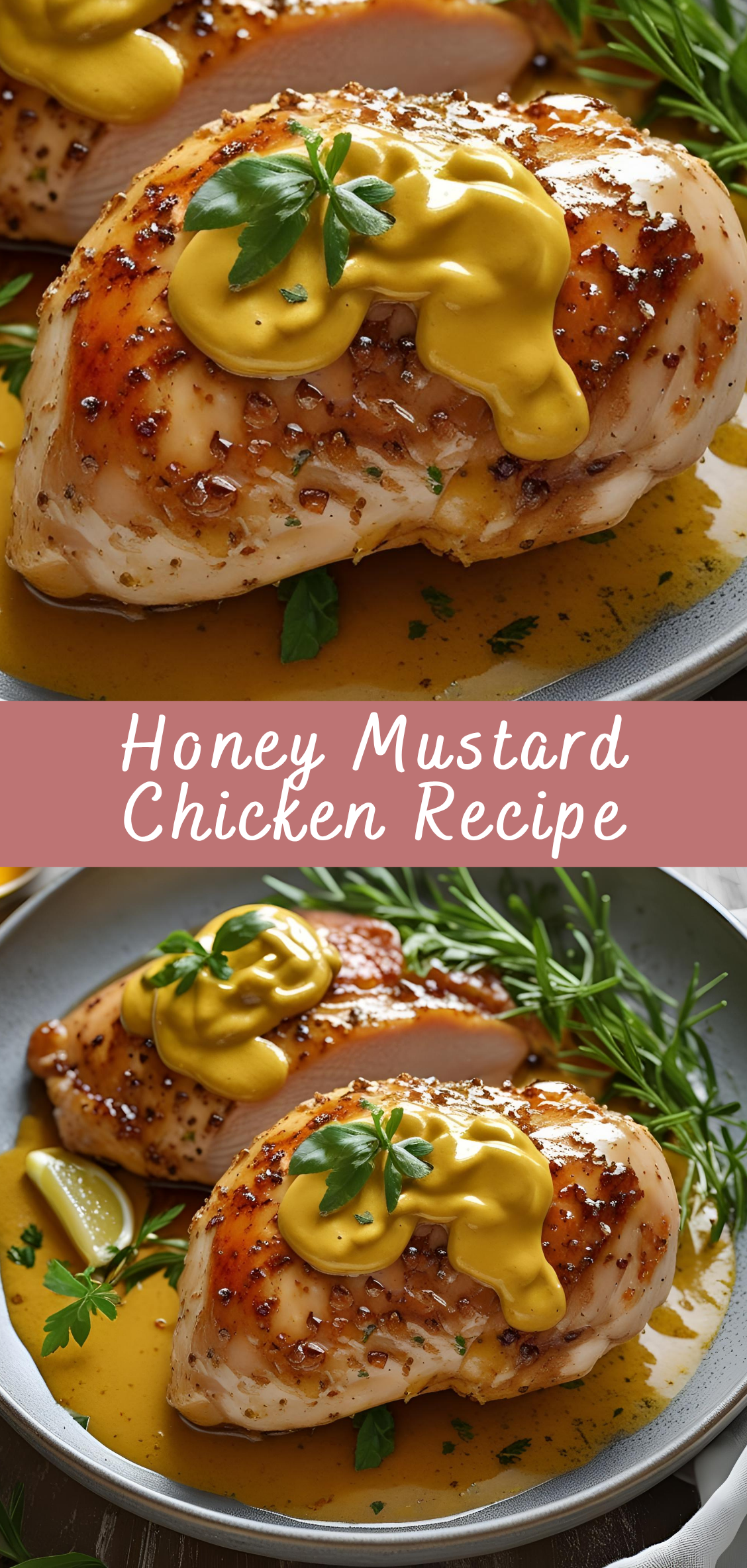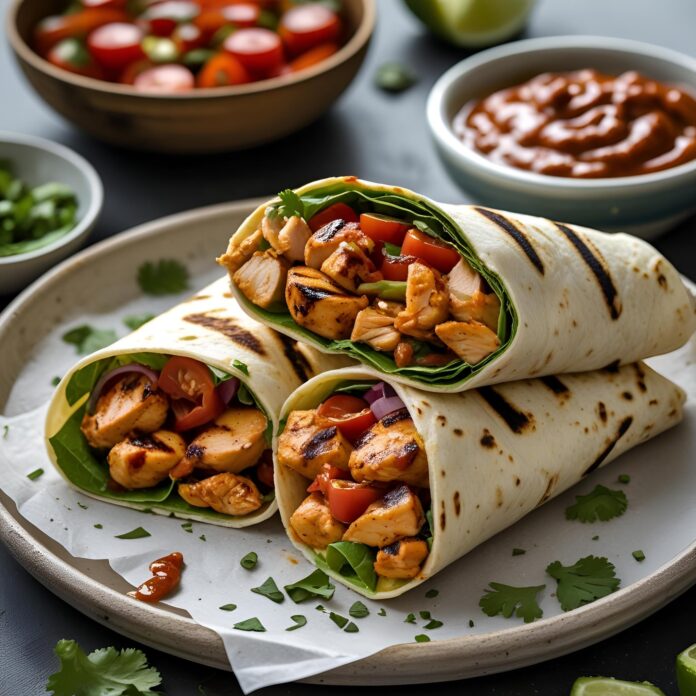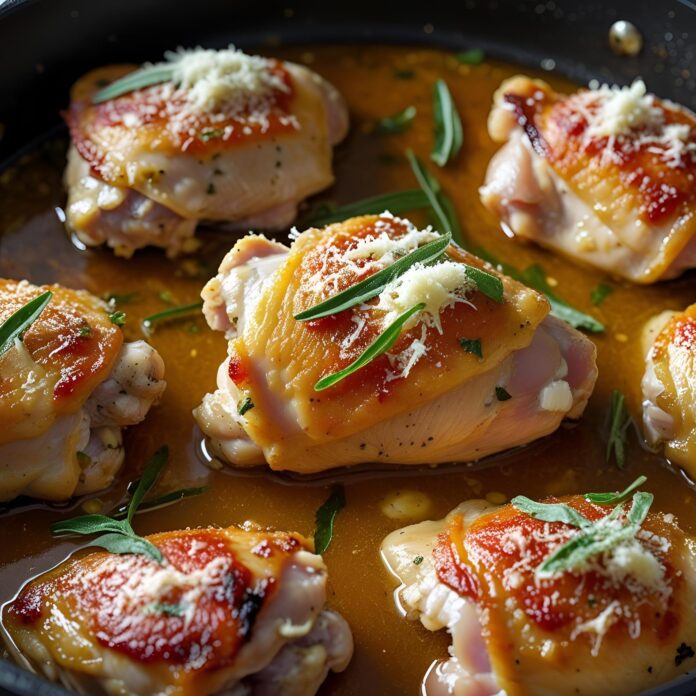Honey Mustard Chicken Recipe
Few dishes strike the perfect balance between sweet, savory, and tangy quite like honey mustard chicken. Beloved across countless households and cuisines, this dish has carved a place for itself in both everyday dinners and special occasions. Whether served fresh from the oven, grilled over an open flame, or simmered gently on the stove, honey mustard chicken embodies a blend of comfort and flavor that continues to resonate with cooks and food lovers alike.
The rich, golden glaze made from the union of honey and mustard doesn’t just elevate the flavor of the chicken—it transforms it. It’s a pairing of opposites that somehow always works: the warmth and sweetness of honey cutting through the sharp, acidic bite of mustard, harmonizing into a sauce that enhances the natural succulence of the chicken without overwhelming it. With just a few simple ingredients, the dish delivers complex flavor and visual appeal, whether presented whole or sliced for sandwiches, salads, or wraps.
Historically, both honey and mustard have been kitchen staples for centuries. Mustard seeds have been used in culinary and medicinal contexts as far back as ancient Rome, while honey was revered not only as a sweetener but also as a symbol of abundance and health in cultures around the world. When these two ingredients are combined into a single sauce—then applied to tender chicken—it’s a union of historical depth and modern versatility.
What makes honey mustard chicken so appealing is its adaptability. The sauce can be tweaked to lean more toward sweetness or acidity depending on taste. The preparation methods are equally flexible, making it possible to roast, grill, pan-fry, or even slow-cook the chicken while still achieving a delicious outcome. This recipe will walk through a traditional oven-baked method while offering alternatives for those looking to experiment with different cooking techniques.
In this comprehensive guide, we will explore everything you need to know to prepare a restaurant-quality honey mustard chicken dish in your own kitchen. From selecting the right cut of chicken to crafting the perfect homemade sauce, and from mastering the cooking process to pairing the dish with complementary sides, this recipe is structured to be both accessible for beginners and enriching for experienced home cooks.
We’ll also delve into storage tips, nutritional insights, and serving suggestions, ensuring that no detail is left unconsidered. Whether you’re cooking for a weeknight dinner or planning a meal for guests, honey mustard chicken is a reliable and crowd-pleasing choice that never goes out of style.
The Culinary Origins and Appeal of Honey Mustard Chicken
The idea of combining sweet and tangy flavors in savory dishes is not new. Many global cuisines have long embraced the contrast between sugar and acid as a way to enhance meats and vegetables. Honey mustard chicken, while particularly popular in contemporary Western cooking, draws inspiration from these deeper culinary traditions.
Historical Use of Honey and Mustard
Honey is one of the oldest known natural sweeteners, with evidence of its use dating back over 8,000 years. Ancient Egyptians offered honey to the gods and used it in both food and medicine. Its antibacterial properties and long shelf life made it both practical and sacred.
Mustard has an equally storied history. Mustard seeds were used in ancient Indian, Chinese, and Roman cuisines, often ground and mixed with wine, vinegar, or oil to create early condiments. In the Roman Empire, a mixture known as “mustum ardens” (burning must) was made by combining unfermented grape juice with ground mustard seeds, giving us the word “mustard” as we know it today.
By the Middle Ages, mustard had become a staple in European kitchens. Monasteries even produced their own blends, with regional differences emerging in France, Germany, and England. The combination of mustard with sweeteners like honey was a natural evolution, especially as sugar and honey became more widely available.
Emergence of Honey Mustard as a Culinary Trend
The honey mustard sauce as we recognize it today—balanced, smooth, and creamy—likely gained popularity in the United States in the mid-20th century. As salad dressings and dipping sauces evolved, the honey-mustard blend quickly became a favorite. It offered something many sauces didn’t: complexity with a minimal ingredient list.
Soon, this sauce began appearing in more than just salads and dips. It was used as a glaze for meats, especially chicken and pork, and began making its way into mainstream American cooking. Fast food chains and restaurants added honey mustard chicken to their menus in the 1980s and 1990s, often breaded or grilled and served in sandwiches, wraps, or as a main course.
The versatility of the sauce played a key role in its enduring popularity. Unlike heavier cream-based sauces or intensely spiced marinades, honey mustard walks a middle path—elegant enough for formal meals but accessible enough for family dinners.
Why Honey Mustard Chicken Works
There’s a reason this dish has become a favorite among home cooks and chefs alike. At the core of its appeal is the contrast and harmony of flavor:
-
Sweetness from the honey gives warmth and balance.
-
Tanginess and heat from the mustard add dimension and prevent the dish from becoming too cloying.
-
Salt and umami from the chicken, especially when properly seasoned or marinated, anchor the flavor profile.
Moreover, the glaze caramelizes beautifully when cooked, forming a sticky coating that enhances both texture and taste. When prepared properly, the chicken remains juicy inside while taking on a golden, flavorful crust on the outside.
Variations Around the World
Though the honey mustard flavor profile is often associated with American cuisine, similar combinations can be found globally:
-
France: Uses Dijon mustard in creamy sauces for chicken and pork, sometimes sweetened subtly with honey or fruit preserves.
-
Germany: Known for strong, grainy mustard sauces often paired with meats. Honey is sometimes used in festive or winter dishes.
-
Middle East and North Africa: While mustard is less common, honey-glazed meats are traditional. When mustard is introduced, it adds depth to spice blends and marinades.
-
Southeast Asia: Fusion cuisines have incorporated honey mustard into stir-fries, glazes, and dipping sauces, blending it with soy, garlic, and ginger for additional complexity.
Each variation reflects how universal the base idea of this dish is, even if it wears a different cultural coat.
Honey Mustard Chicken Recipe
Few dishes strike the perfect balance between sweet, savory, and tangy quite like honey mustard chicken. Beloved across countless households and cuisines, this dish has carved a place for itself in both everyday dinners and special occasions. Whether served fresh from the oven, grilled over an open flame, or simmered gently on the stove, honey mustard chicken embodies a blend of comfort and flavor that continues to resonate with cooks and food lovers alike.
Ingredients
- 4 boneless, skinless chicken breasts (or thighs if preferred)
- Salt and pepper, to taste
- 1 tablespoon olive oil
- 3 tablespoons Dijon mustard
- 2 tablespoons yellow mustard (optional for milder flavor)
- 1/4 cup honey
- 1 tablespoon mayonnaise or Greek yogurt (optional for creaminess)
- 2 teaspoons apple cider vinegar (or lemon juice)
- 2 cloves garlic, minced
- 1/2 teaspoon paprika (optional)
- Fresh thyme or rosemary (optional for garnish)
Instructions
- Preheat Oven (if baking):
Preheat to 375°F (190°C) if baking. You can also cook it on the stovetop. - Season Chicken:
Pat chicken dry. Season both sides with salt, pepper, and a pinch of paprika if using. - Make the Honey Mustard Sauce:
In a small bowl, whisk together:
Dijon mustard
Yellow mustard (if using)
Honey
Garlic
Vinegar or lemon juice
Mayo/Greek yogurt (optional) - Sear Chicken (Optional for Extra Flavor):
In an oven-safe skillet over medium-high heat, add olive oil and sear the chicken for 2–3 minutes per side until lightly browned. - Add Sauce & Bake:
Pour the sauce over the chicken in the skillet or transfer chicken and sauce to a baking dish.
Bake for 20–25 minutes or until internal temp reaches 165°F (74°C).
Alternatively, cook covered on stovetop on medium-low for 20–25 minutes. - Rest & Serve:
Let chicken rest for 5 minutes before slicing. Garnish with herbs if desired.
Notes
- For crispier texture, broil the chicken for the last 2–3 minutes.
- Thighs are juicier and more forgiving if you're new to cooking chicken.
- Serve with roasted potatoes, rice, or steamed vegetables.


